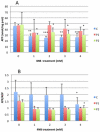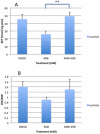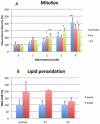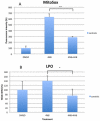Effects of inhibiting CoQ10 biosynthesis with 4-nitrobenzoate in human fibroblasts
- PMID: 22359546
- PMCID: PMC3281033
- DOI: 10.1371/journal.pone.0030606
Effects of inhibiting CoQ10 biosynthesis with 4-nitrobenzoate in human fibroblasts
Abstract
Coenzyme Q(10) (CoQ(10)) is a potent lipophilic antioxidant in cell membranes and a carrier of electrons in the mitochondrial respiratory chain. We previously characterized the effects of varying severities of CoQ(10) deficiency on ROS production and mitochondrial bioenergetics in cells harboring genetic defects of CoQ(10) biosynthesis. We observed a unimodal distribution of ROS production with CoQ(10) deficiency: cells with <20% of CoQ(10) and 50-70% of CoQ(10) did not generate excess ROS while cells with 30-45% of CoQ(10) showed increased ROS production and lipid peroxidation. Because our previous studies were limited to a small number of mutant cell lines with heterogeneous molecular defects, here, we treated 5 control and 2 mildly CoQ(10) deficient fibroblasts with varying doses of 4-nitrobenzoate (4-NB), an analog of 4-hydroxybenzoate (4-HB) and inhibitor of 4-para-hydroxybenzoate:polyprenyl transferase (COQ2) to induce a range of CoQ(10) deficiencies. Our results support the concept that the degree of CoQ(10) deficiency in cells dictates the extent of ATP synthesis defects and ROS production and that 40-50% residual CoQ(10) produces maximal oxidative stress and cell death.
Conflict of interest statement
Figures













Similar articles
-
Reactive oxygen species, oxidative stress, and cell death correlate with level of CoQ10 deficiency.FASEB J. 2010 Oct;24(10):3733-43. doi: 10.1096/fj.09-152728. Epub 2010 May 21. FASEB J. 2010. PMID: 20495179 Free PMC article.
-
Respiratory chain dysfunction and oxidative stress correlate with severity of primary CoQ10 deficiency.FASEB J. 2008 Jun;22(6):1874-85. doi: 10.1096/fj.07-100149. Epub 2008 Jan 29. FASEB J. 2008. PMID: 18230681 Free PMC article.
-
Coenzyme Q biosynthesis inhibition induces HIF-1α stabilization and metabolic switch toward glycolysis.FEBS J. 2021 Mar;288(6):1956-1974. doi: 10.1111/febs.15561. Epub 2020 Sep 20. FEBS J. 2021. PMID: 32898935
-
Coenzyme Q biosynthesis in health and disease.Biochim Biophys Acta. 2016 Aug;1857(8):1079-1085. doi: 10.1016/j.bbabio.2016.03.036. Epub 2016 Apr 7. Biochim Biophys Acta. 2016. PMID: 27060254 Review.
-
Genetic bases and clinical manifestations of coenzyme Q10 (CoQ 10) deficiency.J Inherit Metab Dis. 2015 Jan;38(1):145-56. doi: 10.1007/s10545-014-9749-9. Epub 2014 Aug 5. J Inherit Metab Dis. 2015. PMID: 25091424 Review.
Cited by
-
Effects of Supplementation with Natural Antioxidants on Oocytes and Preimplantation Embryos.Antioxidants (Basel). 2020 Jul 12;9(7):612. doi: 10.3390/antiox9070612. Antioxidants (Basel). 2020. PMID: 32664650 Free PMC article. Review.
-
Mitochondrial CoQ deficiency is a common driver of mitochondrial oxidants and insulin resistance.Elife. 2018 Feb 6;7:e32111. doi: 10.7554/eLife.32111. Elife. 2018. PMID: 29402381 Free PMC article.
-
Coenzyme Q deficiency causes impairment of the sulfide oxidation pathway.EMBO Mol Med. 2017 Jan;9(1):96-111. doi: 10.15252/emmm.201606356. EMBO Mol Med. 2017. PMID: 27856618 Free PMC article.
-
The association between coenzyme Q10 concentrations in follicular fluid with embryo morphokinetics and pregnancy rate in assisted reproductive techniques.J Assist Reprod Genet. 2017 May;34(5):599-605. doi: 10.1007/s10815-017-0882-x. Epub 2017 Feb 9. J Assist Reprod Genet. 2017. PMID: 28185121 Free PMC article.
-
The treatment of primary CoQ deficiency requires the targeting of multiple pathogenic mechanisms.Commun Med (Lond). 2025 Jul 10;5(1):286. doi: 10.1038/s43856-025-01000-8. Commun Med (Lond). 2025. PMID: 40640372 Free PMC article.
References
Publication types
MeSH terms
Substances
Grants and funding
LinkOut - more resources
Full Text Sources

